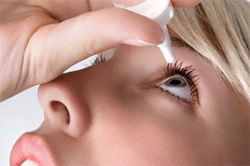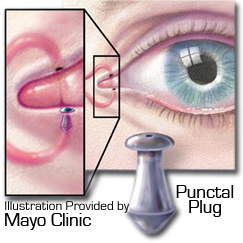Dry Eyes ~ Chronic Dry Eye

One of the most common questions we hear in our practice is, “If my eyes are dry then why are they always wet?” Do you have "Chronic Dry Eyes?" Do you know the symptoms? Are your eyes always watering? If so, you may have Chronic Dry Eyes.
"The average person blinks their eyes
about 4.2 million times per year."
To understand dry eye one must understand the anatomy of the eye. Over time our eyes have evolved into very precise optical instruments. Tears play an important role in lubricating our eyes and providing sharp vision. Any deficiency in the tear layer can cause an improper focusing of light and blurry vision.
The tear layer consists of three separate layers: mucous, water, and oil. The mucous layer provides a base over the eye. The water layer covers the mucous and provides most of the lubrication. The oil layer is the outermost layer and keeps the water layer from evaporating.
We unconsciously blink thousands of times a day. In between blinks approximately 15% of our tears evaporate. If we concentrate on something, our blink rate decreases and more tears evaporate. Eventually too few tears remain to lubricate the eyes and focus light.
Causes of Dry Eye
Many factors contribute to dry eye. The treatment is aimed at restoring the delicate balance with in the tear layer. Dry eye is caused by age, activities, medications and medical conditions. As we age our bodies produce fewer tears. For instance a 60 year old produces 60% fewer tears than an 18 year old. Everyday activities including, reading, writing, watching TV and driving, all require an increase in concentration and a decrease in the blink rate. More tears evaporate and dry eye develops. Medications often times decrease the volume of tears produced. Anti-histamines and B-Blockers are commonly used examples. Environment plays a large role in evaporation rates. A dry, air-conditioned environment, filled with dust and pollen pollutes the tear layer and decreases its efficiency. Medical conditions including collagen/vascular diseases like Rheumatoid Arthritis, Sjogrens, etc. all cause a decrease in tear production.
Symptoms of Dry Eye
As the tear layer thins, the patient notices blurry vision that may clear for a few seconds after blinking. Eventually a foreign body feeling develops—described as sand in the eye - and the eye reflexively tears. These tears consist of the water layer yet they do not provide relief because the primary problem is a deficient oil layer.
Meibomian Gland Dysfunction
Over time physiologic changes with in the eyelids leads to blockage of the oil-producing glands located along the base of the lashes. This condition causes inflammation of the lids leading to sore, red, lid margins, an increase in the tear’s evaporation rate, and the development of dry eye. The treatment for this type of dry eye attempts to open these oil glands and decrease the tears’ evaporation rate.
Dry Eye Treatment
- Warm compresses are the best treatment for dry eye. Wetting a washcloth under warm water and applying to the closed lids helps to melt the solidified oil with in the glands.
- Artificial tears used 4-8x/day help flush the eye and clear accumulated environmental and inflammatory cellular byproducts.
- Ophthalmic medications are used to treat underlying bacterial infections common to dry eye.
Punctal Plug

RESTASIS®
A new prescription eye drop used to control chronic dry eye. The inflammation which develops in chronic dry eye can itself cause the eye to become drier. Restasis® inhibits the inflammatory cascade and allows the eye to recover from the effects of long term dry eye. For more information on dry eyes and Restasis®, visit www.restasis.com
Dealing with Dry Eye (PDF) - This document requires Adobe® Reader® to view. If you do not have this installed on your computer, you can get it free from Adobe by clicking here
FDA Consumer magazine (May-June 2005 issue),
by Michelle Meadows.
Posted: August 23, 2005.
FDA article providing an overview of dry eye and treatment options, which include artificial tears, RESTASIS®, and punctal plugs.
Dry eye is not curable, it is only controllable. Treatment must be tailored to the level of symptoms and the underlying cause. For more information contact Provision.

